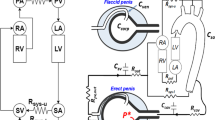Abstract
In order to further our understanding of the physiology of corporal veno-occlusion, we developed a theory of a possible contribution to corporal venous outflow resistance which occurs as the result of venule stretching with resultant luminal narrowing when penile volume increases during the erection process. We stretched non-biological tubes and rabbit abdominal vena cava segments, performed flow-based and volume-based experiments to calculate the magnitude of N, the newly defined ‘stretch-associated luminal constrictability’ factor. We solved for (Rs/Ru), the ratio of the venule fluid resistance in the stretched state (Rs) to the unstretched state (Ru), to quantify the projected increases in fluid resistance as well as Q.Ru where Q is the subtunical venule flow rate.
For a given tube, N was found to be essentially constant for different amounts of stretch. A theory was formulated which predicted Rs andQ as a function of N, ΔP (intracavernosal pressure increase); VE/VF (tunical distensibility); X (cavernosal expandability) andRu. Based on the magnitude ofN=2, this theory predicts that patients with the highest values of bothVE/VF andX would have maximalRs values, approaching infinity (complete occlusion) at a low ΔP near 5 mmHg. In contrast, patients with low values of both VE/VF (eg Peyronie’s disease) and X (eg corporal fibrosis), would be predicted to have minimalRs values. For example, a hypothetical patient with the lowest values of VE/VF and X would yieldRs values only approaching 7.9 times that of unstretched values at a ΔP increase of 90 mmHg.
We concluded to that stretch-associated venule resistance may occur as a result of decreased sub-tunical venule diameter and increased sub-tunical venule length. In individual patients, stretch-associated venule resistance may either dominate or be a minor component of the overall mechanism of corporal veno-occlusion.
Similar content being viewed by others
Author information
Authors and Affiliations
Rights and permissions
About this article
Cite this article
Udelson, D., L’Esperance, J., Morales, A. et al. The mechanics of corporal veno-occlusion in penile erection: a theory on the effect of stretch-associated luminal constrictability on outflow resistance. Int J Impot Res 12, 315–327 (2000). https://doi.org/10.1038/sj.ijir.3900628
Received:
Revised:
Accepted:
Published:
Issue Date:
DOI: https://doi.org/10.1038/sj.ijir.3900628
- Springer Nature Limited
Keywords
This article is cited by
-
Physiological regulation of penile arteries and veins
International Journal of Impotence Research (2008)




